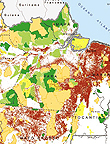While nearly 44 percent of the Brazilian Amazon has protected status, poor management and limited oversight make many areas susceptible to human encroachment and development, including logging and mining, according to a new report. As of late 2010, almost 2.2 million square kilometers of the Amazon was protected, with about half of that area falling within the borders of national parks and the other half protected as indigenous territories. But even within those areas, more than 12,000 square kilometers of forest were cleared from 1998 to 2009, particularly in areas designated as “sustainable use” reserves, according to the study by Imazon and the Instituto Socioambiental (ISA). The main threat is lack of planning or oversight, researchers say. Half of the protected areas have no approved management plan, and 45 percent have no management council. According to the report, 1,338 mining titles have been granted in protected areas and another 10,348 are awaiting approval.
Nearly Half of Amazon Is Protected But Vulnerable, Report Says
More From E360
-
OPINION
Forest Service Plan Threatens the Heart of an Alaskan Wilderness
-
INTERVIEW
Pakistan’s Solar Revolution Is Bringing Power to the People
-
Food & Agriculture
In Uganda, Deadly Landslides Force an Agricultural Reckoning
-
Energy
Why U.S. Geothermal May Advance, Despite Political Headwinds
-
Food & Agriculture
In War Zones, a Race to Save Key Seeds Needed to Feed the World
-
Climate
Lightning Strikes the Arctic: What Will It Mean for the Far North?
-
RIVERS
A Win for Farmers and Tribes Brings New Hope to the Klamath
-
Solutions
Deconstructing Buildings: The Quest for New Life for Old Wood
-
NATURAL DEFENSES
How Restored Wetlands Can Protect Europe from Russian Invasion
-
Solutions
Birds vs. Wind Turbines: New Research Aims to Prevent Deaths
-
Biodiversity
Cambodian Forest Defenders at Risk for Exposing Illegal Logging
-
OPINION
The ‘Green’ Aviation Fuel That Would Increase Carbon Emissions
